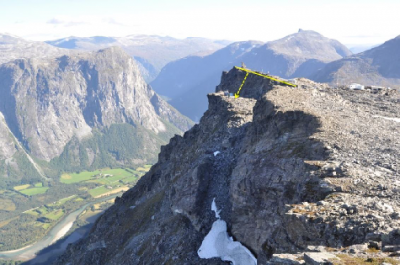State geologists have started round-the-clock monitoring of two mountainous areas in the heart of southwestern Norway’s most popular tourist region. They’re worried about unstable mountainsides that could crash down into the fjords below.

Potential landslides could in turn set off what amount to massive waves that would crash into communities at the end of the fjord, in this case the popular tourist destinations of Flåm and Eidfjord.
State waterways and energy directorate NVE reported this week that it had just completed a danger- and risk assessment of portions of two mountains known as Stiksmoen in Aurland and Tussafoten in Eidfjord. Both are now classified as posing “high risk” after an evaluation of the annual probability and possible consequences of a landslide.
Stiksmoen has been branded as an “unstable” portion of a mountain slope located around 120 meters above the fjord at the southern end of the Aurlandsfjord. “A possible landslide from Stiksmoen could be able to set off a flodbølge (a tsunami of sorts) that could hit the center of Flåm,” NVE wrote in a press release on Tuesday.
The Aurlandsfjord is a southeastern arm of the large Sognefjord. Flåm is located at the bottom of the Aurlandsfjord and best known as the end station for a scenic trainline (Flåmsbanen) that runs down the mountain from Myrdal. It’s also a popular stop for cruiseships.
Tussafoten, meanwhile, was described as “a large unstable portion” of the mountain that lies 1,100 meters above Øvre Eidfjord and the lake known as Eidfjordvatnet. Geologists have monitored the area since 2017 and found that portions of the mountain are moving as much as five centimeters a year. “A landslide could hit Øvre Eidfjord and reach Eidfjordvatnet,” NVE wrote, setting off a smaller tidal wave.
The scenic Eidfjord and the town with the same name are located at the far eastern end of the fjords that include Norway’s Hardangerfjord. The area has long attracted both cruiseships and tourists arriving by bus, train and car.
Nine mountain areas now under surveillance
The continual monitoring of Stiksmoen and Tussafoten brings the total number of unstable mountains under constant surveillance in Norway to nine. They include Åknes in Stranda, Mannen in Rauma, Hegguraksla in Møre og Romsdal, Joasetbergi also in Aurland and three in Troms og Finnmark in Northern Norway: Gámanjunni 3, Jettan and Indre Nordnes, all in the municipality of Kåfjord.
NVE is now recommending that the local townships of Eidfjord and Aurland establish disaster preparedness plans. “That would include warning systems for the local population, establishment of clear evacuation zones and a plan for maintaining local government services,” said Lars Harald Blikra, leader of the landslide division at NVE. The state directorate itself will now be responsible for alerting the local authorities including police, emergency services and the local county governor to any changes in the danger level.

The continual monitoring of any movement in the mountains will provide live data “and make it possible to warn and evacuate people in the danger zone,” Blikra said. That played out numerous times with another unstable portion of the mountain known as Mannen, which rises high above a valley floor at Rauma in the Romsdal region of central Norway. After years of evacuations and closure of the train line running below the mountain, part of Mannen finally broke away and the risk level has since subsided. Surveillance, however, continues.
Tunnels and roads are located near both of the new high-risk areas in Eidfjord and Aurland/Flåm. Blikra said the new classification of both as potentially dangerous “should also be taken into consideration during area planning” for the future.
“This is serious,” said Aurland Mayor Trygve Skjerdal of the Center Party. “We have businesses and people living right under the mountain, and in the summer there’s lots of activity from all the tourists.” As many as 1.5 million tourists visited the area every year before the Corona crisis halted most travel. Tourists have been expected to return this summer, although the numbers of cruiseships may be fewer because of new restrictions on their carbon emissions.
Residents of Flåm expressed gratitude for the new, constant monitoring of their scenic if troublesome local mountainside. “We are blessed with lots of slides,” Anders Fretheim told Norwegian Broadcasting (NRK). He rents out cabins to tourists, many of whom also stay at the local Fretheim Hotel.
“For Flåm and the tourists, it’s great that they’re starting to have constant surveillance so that it will be safe to come here,” Fretheim said.
newsinenglish.no/Nina Berglund

